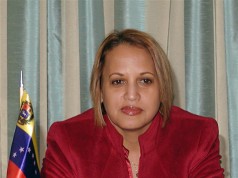With more ways to get aid into the country,
including the opening of the city’s seaport on Thursday and a more
efficient system of food and water distribution, recovery began to seem
possible.
“I think we’re beginning to turn a corner in logistics,” said
This week — as the U.N. coordinated 30 countries and
400 non-governmental organizations and relief agencies — more
distribution points for food and water opened, along with new medical
clinics. The roads have been cleared for trucks.
The U.S. military increased the capacity of the
airport from 30 planes daily before the quake to 130, and three new
airfields opened. The
seaport, battered in the quake, opened for limited deliveries. Some
relief agencies began shifting their focus to long-term relief and
reconstruction.
Still, much more is needed as
struggles to recover from an earthquake that killed as many as 200,000
and left up to 2 million living in the streets and in tent cities.
The world pledged nearly
after the quake struck. Tons of supplies were sent. Thousands of relief
workers and soldiers hit the ground, working to make sense of a
colossal natural disaster with a price infinitely higher than broken
buildings.
But faced with a collapsed city, a broken port, a
damaged airport and a staggering number of dead, dying and needy, much
of the aid slipped into limbo, stuck between promise and delivery. Some
planes carrying supplies were even turned away.
“
On Thursday,
in partnership with USAID, started distribution of 2,000 metric tons of
food — enough to feed more than 94,000 individuals in Petionville,
Delmas and
Air drops of food and water by C-17 aircraft continued, too, with
14,000 water bottles and 14,500 pre-packaged military meals for people
in Mirebalais, about 25 miles northeast of
The USS Carl Vinson is producing 100,000 gallons of
potable water daily and water tanks are being installed in each zone of
the city.
But relief officials warn there are still kinks in the effort and much to be done.
“With each day, we are building momentum and the
logistics are improving. We are starting to get aid to the areas
relatively rapidly,” said
“We have done a lot, but we have a long way to go. We are still not
getting aid in the quantities we need and not reaching all the sectors.”
And some Haitians worry that even with the port’s partial reopening, getting to food to people regularly will be difficult.
“We have a huge distribution problem. I am not sure
that all of the coordination that’s being done is being done properly,”
said
improving. Next week, we will see a better distribution system put in
place. Now a lot of aid is sitting at the airport, and it is a problem.”
Squatters at a camp in Petionville, one of the
hardest-hit cities, said most aid they received came from local
agencies and volunteers — not international groups.
“Everybody is a victim here,” said Francilien Manot, 40.
Several thousand homeless people occupy
a humanitarian agency, has set up water distribution at the south end
of the park and a Christian humanitarian agency donated tarps.
“This is one of the biggest scale emergency
operations ever, but the magnitude of the need is so huge that we just
have to figure out how to scale it up even more,” said the program’s
executive director,
In the first week, the odds were against the global relief effort.
The staggering scale of destruction in an already
needy country, a complicated coordination effort led by the U.N. and
the Haitian government, and security issues have conspired to slow the
humanitarian campaign to help
“It’s chaos because there’s been a disaster, and we try to reduce that chaos as best we can,” the U.N.’s Holmes said.
“Everybody’s been frustrated about how long that’s
taken,” he said, but added that in large disasters, “it takes time to
get goods moving on the street.”
The
“Even before earthquake, the infrastructure was not
very strong, and there was never a really reliable good transportation
system,” said Gutierrez-White, of the
The earthquake destroyed some the most critical
on-the-ground elements of any rescue operation. The U.N. headquarters
was leveled, relief staff killed or injured, and existing stockpiles of
supplies lost.
“Local governments help take the strain off
international workers in the early days after a disaster, but in this
case, the Haitian government was knocked out of action by the
earthquake last week,” Holmes said.
Holmes said the relief effort is making inroads as
aid groups organize in a U.N.-led “cluster system” that combines
resources. Areas include food, medicine, sanitation and shelter.
U.N. officials meet daily with all the aid groups — including some, like the
that they don’t directly control — to make sure the supplies get where
they’re needed most and aren’t duplicated. They also meet with U.S.
military generals at Central Command.
The U.S. military makes decisions about flight
priorities at the airport, but U.N. staffers work in the control tower
offering advice and making prioritization requests for incoming flights.
“We’re trying as best we can to give priority to medical flights,” Holmes said. “The airport is working well.”
But the challenges are far from over as the relief effort moves from rescue to rebuilding.
“The U.S. military needs to prioritize getting clean water and other essential needs to the population,” said
—
(c) 2010, The Miami Herald.
Visit
Distributed by McClatchy-Tribune Information Services.













